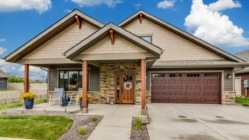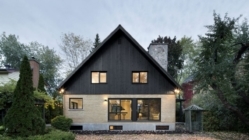
But what exactly are they and how do they work? Here is everything you need to know about saving money with an 80-10-10 loan.
What Is An 80-10-10 Loan?
80-10-10 loans or piggyback mortgages are different names for combination financing. This includes taking a conventional first loan and a simultaneous second loan.
The second loan is often a Home Equity Line of Credit (HELOC).
Combination financing is a creative tool you can use to push above county loan limits, remove mortgage insurance, or bridge appraisal shortfalls.
How Do 80-10-10 Loans Work?
The terminology “80-10-10” may sound confusing at first, but the concept is simple. It refers to the percentage of value that is financed versus out-of-pocket.
80% of the home is financed with a conventional mortgage. 10% of the home is financed with a HELOC or fixed rate second lien, and the remaining 10% is the buyer’s down payment. Hence, “80-10-10”.
You can opt to put down more than 10% if you choose. However, the minimum threshold is generally 10% down. Some HELOC providers do allow for as little as 5% down.
JVM’s most common 80-10-10 providers require a minimum of 10.01% down.
Scenario
If you want to purchase a home at a $1.5M purchase price, you will likely need a 20% down payment and 12 months of reserves to qualify for a jumbo loan exceeding the county loan limit.
Instead, you can put 10.01% down and take a conventional first loan at the county loan limit. Then. you can take a piggyback second loan to cover the difference above the loan limit.
This way, you avoid paying for mortgage insurance and can save for a full 20% down payment and 12 months of mortgage payment in reserves.
- Purchase Price: $1.5M
- Down Payment: 10.01%
- 80-10-10 Loan: $970,800 Conventional First Loan (5.875% or $5,742 Monthly P&I) + $379,050 HELOC (6% Interest Only for 10 Years or $1,895)
- Total Monthly Payment: $7,637
- Benefits: No Mortgage Insurance and No Reserves Needed
If you have strong income and credit , but limited assets and reserves, it could be wise to consider an 80-10-10 loan. They allow for a higher price range while taking advantage of lower, interest-only payments on the second loan HELOC.
Once the home has appreciated to the point of 20% equity, we can look to refinance, removing the variable rate HELOC by rolling it into the new principal loan.
Why Use An 80-10-10 Loan Instead of A Traditional Mortgage Loan?
Combination financing has several benefits, but we don’t always recommend it. Here are the pros and cons of using an 80-10-10 loan instead of a traditional mortgage loan.
Pros
Avoid Mortgage Insurance: With less than 20% down, typically you are “on the hook” for mortgage insurance in some form – either paid monthly or in lump sum. With combination financing, the 2nd mortgage or equity line counts toward your down payment. So 10% down payment + 10% HELOC lowers the loan-to-value (LTV) of the first loan to 80%, which is the maximum threshold to avoid mortgage insurance.
Increased Purchase Price: You can use combination financing to reach higher purchase prices – stretching above the maximum conventional mortgage limits. By taking out a conventional loan of up to $647K or $970K depending on the county, with an additional HELOC, you are not restricted by the county loan limits when assets are limited.
Avoid Jumbo Financing Requirements: You may be highly qualified – excellent credit and strong income – but don’t have cash reserves or retirement savings to qualify for jumbo financing. In this case, combination financing can be an excellent fit.
Interest Only Payments: Our most popular HELOC provider allows for interest-only payment for the first 10 years of the loan term. This provides excellent flexibility – as well as the opportunity to refinance within those 10 years.
Cons
Variable Rates: HELOC rates are adjustable and tied to the U.S. Prime Rate. If the prime rate increases or decreases, the HELOC rate will follow. Typically HELOC rates are 2-3% higher than conventional mortgage rates, though many factors impact the rate associated with an individual’s HELOC.
Higher Monthly Payment: If you can put 20-25% down but opt for combination financing to keep liquid cash available, you will have a higher monthly payment. This is because principle and interest payments are required on the conventional loan and interest-only payments (at minimum) on the secondary loan. Interest rates for the first loan are higher than conventional financing due to the risk factors of taking two loans at once.
Stricter Requirements Than Conventional Financing: Although 80-10-10 buyers will receive a conventional first loan, the underwriting guidelines are stricter in terms of minimum credit scores, debt to income requirements, and interest rates.
How Do You Qualify?
To pursue a combination loan, lenders must analyze your financial profile just like the traditional loan process. Since each loan will have its own approval guidelines, 80-10-10 loans are more complicated than other loan products.
This is a great reason to lean on JVM’s expertise with these loan products.
Key Requirements
Lower Debt to Income (DTI) Requirements: 80-10-10 loans are stricter than conventional loans but more lenient than jumbo loans. While jumbo loans will cap DTI at 43% and conventional at 49%, combination loans offer a middle ground capping DTI at 45%.
Higher Credit Score Threshold: A 620 minimum credit score can get you a conventional loan. However, many HELOC providers require higher scores to offset the risks of lending two loans at once. Most combination providers set their limit at 680, although there may be more lenient options that allow for a minimum of 660.
Additional Closing Costs: Closing two loans does not necessarily mean you will pay double the amount in closing costs. Most HELOC providers will charge an additional fee to close on your second loan, which often lands in the ~$300 range. They may also charge an annual maintenance fee for each year your HELOC is serviced, with no fee for early termination of the loan.
The Bottom Line
It is important to consider all ways to save money when buying a home, and an 80-10-10 loan may be an excellent option. However, there are pros and cons to this loan type to discuss with your mortgage lender.
Reach out today to speak with a Client Advisor and learn more about 80-10-10 loans.
























